spring.handlers 文件内容如下:
http://www.springframework.org/schema/c=org.springframework.beans.factory.xml.SimpleConstructorNamespaceHandler
http://www.springframework.org/schema/p=org.springframework.beans.factory.xml.SimplePropertyNamespaceHandler
http://www.springframework.org/schema/util=org.springframework.beans.factory.xml.UtilNamespaceHandler
这其实一个映射配置,每一个名称空间对应的处理类在这里进行配置。
spring.schemas 文件内容如下(部分):
http://www.springframework.org/schema/beans/spring-beans-2.0.xsd=org/springframework/beans/factory/xml/spring-beans.xsd
http://www.springframework.org/schema/beans/spring-beans-2.5.xsd=org/springframework/beans/factory/xml/spring-beans.xsd
http://www.springframework.org/schema/beans/spring-beans-3.0.xsd=org/springframework/beans/factory/xml/spring-beans.xsd
http://www.springframework.org/schema/beans/spring-beans-3.1.xsd=org/springframework/beans/factory/xml/spring-beans.xsd
http://www.springframework.org/schema/beans/spring-beans-3.2.xsd=org/springframework/beans/factory/xml/spring-beans.xsd
http://www.springframework.org/schema/beans/spring-beans-4.0.xsd=org/springframework/beans/factory/xml/spring-beans.xsd
http://www.springframework.org/schema/beans/spring-beans-4.1.xsd=org/springframework/beans/factory/xml/spring-beans.xsd
http://www.springframework.org/schema/beans/spring-beans-4.2.xsd=org/springframework/beans/factory/xml/spring-beans.xsd
http://www.springframework.org/schema/beans/spring-beans-4.3.xsd=org/springframework/beans/factory/xml/spring-beans.xsd
http://www.springframework.org/schema/beans/spring-beans.xsd=org/springframework/beans/factory/xml/spring-beans.xsd
可以看到,各种版本以及没有版本号的约束文件,都对应了同一个文件,就是 org/springframework/beans/factory/xml/spring-beans.xsd,打开这个文件目录,我们就可以看到约束文件:
所以我们虽然在 Spring 的 XML 配置中看到的约束文件是一个在线地址,实际上约束文件是从本地 jar 中读取的。
EntityResolver 就是用来处理 XML 验证的。我们先来看下 EntityResolver 接口的定义:
public interface EntityResolver {
public abstract InputSource resolveEntity (String publicId,
String systemId)
throws SAXException, IOException;
}
接口中就只有一个方法,就是加载约束文件。在 Spring 中,EntityResolver 的实现类是 DelegatingEntityResolver:
public class DelegatingEntityResolver implements EntityResolver {
public static final String DTD_SUFFIX = “.dtd”;
public static final String XSD_SUFFIX = “.xsd”;
private final EntityResolver dtdResolver;
private final EntityResolver schemaResolver;
public DelegatingEntityResolver(@Nullable ClassLoader classLoader) {
this.dtdResolver = new BeansDtdResolver();
this.schemaResolver = new PluggableSchemaResolver(classLoader);
}
public DelegatingEntityResolver(EntityResolver dtdResolver, EntityResolver schemaResolver) {
this.dtdResolver = dtdResolver;
this.schemaResolver = schemaResolver;
}
@Override
@Nullable
public InputSource resolveEntity(@Nullable String publicId, @Nullable String systemId)
throws SAXException, IOException {
if (systemId != null) {
if (systemId.endsWith(DTD_SUFFIX)) {
return this.dtdResolver.resolveEntity(publicId, systemId);
}
else if (systemId.endsWith(XSD_SUFFIX)) {
return this.schemaResolver.resolveEntity(publicId, systemId);
}
}
return null;
}
@Override
public String toString() {
return "EntityResolver delegating " + XSD_SUFFIX + " to " + this.schemaResolver +
" and " + DTD_SUFFIX + " to " + this.dtdResolver;
}
}
在 DelegatingEntityResolver 类中:
-
首先通过两种不同的后缀来区分不同的约束。
-
然后定义了 dtdResolver 和 schemaResolver 两个不同的变量,对应的类型分别是 BeansDtdResolver 和 PluggableSchemaResolver,也就是 dtd 和 schema 的约束验证分别由这两个类来处理。
-
在 resolveEntity 方法中,根据解析出来不同的后缀,分别交由不同的 EntityResolver 来处理。resolveEntity 解析中有两个参数,如果是 dtd 解析的话,publicId 是有值的,如果是 schema 解析,publicId 为 null,而 systemId 则始终指向具体的约束文件。
由于现在大部分都是 schema 约束,所以这里我们就来重点看下 PluggableSchemaResolver 类的实现:
public class PluggableSchemaResolver implements EntityResolver {
public static final String DEFAULT_SCHEMA_MAPPINGS_LOCATION = “META-INF/spring.schemas”;
private static final Log logger = LogFactory.getLog(PluggableSchemaResolver.class);
@Nullable
private final ClassLoader classLoader;
private final String schemaMappingsLocation;
@Nullable
private volatile Map<String, String> schemaMappings;
public PluggableSchemaResolver(@Nullable ClassLoader classLoader) {
this.classLoader = classLoader;
this.schemaMappingsLocation = DEFAULT_SCHEMA_MAPPINGS_LOCATION;
}
public PluggableSchemaResolver(@Nullable ClassLoader classLoader, String schemaMappingsLocation) {
Assert.hasText(schemaMappingsLocation, “‘schemaMappingsLocation’ must not be empty”);
this.classLoader = classLoader;
this.schemaMappingsLocation = schemaMappingsLocation;
}
@Override
@Nullable
public InputSource resolveEntity(@Nullable String publicId, @Nullable String systemId) throws IOException {
if (logger.isTraceEnabled()) {
logger.trace(“Trying to resolve XML entity with public id [” + publicId +
“] and system id [” + systemId + “]”);
}
if (systemId != null) {
String resourceLocation = getSchemaMappings().get(systemId);
if (resourceLocation == null && systemId.startsWith(“https:”)) {
resourceLocation = getSchemaMappings().get(“http:” + systemId.substring(6));
}
if (resourceLocation != null) {
Resource resource = new ClassPathResource(resourceLocation, this.classLoader);
try {
InputSource source = new InputSource(resource.getInputStream());
source.setPublicId(publicId);
source.setSystemId(systemId);
if (logger.isTraceEnabled()) {
logger.trace(“Found XML schema [” + systemId + "] in classpath: " + resourceLocation);
}
return source;
}
catch (FileNotFoundException ex) {
if (logger.isDebugEnabled()) {
logger.debug(“Could not find XML schema [” + systemId + "]: " + resource, ex);
}
}
}
}
return null;
}
private Map<String, String> getSchemaMappings() {
Map<String, String> schemaMappings = this.schemaMappings;
if (schemaMappings == null) {
synchronized (this) {
schemaMappings = this.schemaMappings;
if (schemaMappings == null) {
try {
Properties mappings =
PropertiesLoaderUtils.loadAllProperties(this.schemaMappingsLocation, this.classLoader);
schemaMappings = new ConcurrentHashMap<>(mappings.size());
CollectionUtils.mergePropertiesIntoMap(mappings, schemaMappings);
this.schemaMappings = schemaMappings;
}
catch (IOException ex) {
throw new IllegalStateException(
“Unable to load schema mappings from location [” + this.schemaMappingsLocation + “]”, ex);
}
}
}
}
return schemaMappings;
}
@Override
public String toString() {
return "EntityResolver using schema mappings " + getSchemaMappings();
}
}
-
在这个类中,一上来先通过 DEFAULT_SCHEMA_MAPPINGS_LOCATION 变量定义了 spring.schemas 文件的位置。
-
getSchemaMappings 方法则是将 spring.schemas 文件中的内容读取成一个 Map 加载进来。
-
在 resolveEntity 方法中,根据 systemId 找到文件路径,systemId 是
http\://www.springframework.org/schema/beans/spring-beans.xsd格式,文件路径则是org/springframework/beans/factory/xml/spring-beans.xsd,如果第一次没有加载到,就把用户的https:替换成http:再去加载。 -
有了文件路径,接下来调用 ClassPathResource 去获取一个 Resource 对象,这块可以参考本系列第二篇,这里我就不再赘述。
-
最后构造一个 InputSource 返回即可。
在上篇文章中,我们获取 EntityResolver 是通过 getEntityResolver 方法来获取的:
protected EntityResolver getEntityResolver() {
if (this.entityResolver == null) {
// Determine default EntityResolver to use.
ResourceLoader resourceLoader = getResourceLoader();
if (resourceLoader != null) {
this.entityResolver = new ResourceEntityResolver(resourceLoader);
}
else {
this.entityResolver = new DelegatingEntityResolver(getBeanClassLoader());
}
}
return this.entityResolver;
}
这里最终返回的是 ResourceEntityResolver,ResourceEntityResolver 继承自 DelegatingEntityResolver,当调用 resolveEntity 方法时,也是先调用父类的该方法,进行处理,如果父类方法处理成功了,就直接返回父类方法给出的结果,如果父类方法处理失败了,则在 ResourceEntityResolver 中通过资源的相对路径再次尝试加载。
最后
自我介绍一下,小编13年上海交大毕业,曾经在小公司待过,也去过华为、OPPO等大厂,18年进入阿里一直到现在。
深知大多数Java工程师,想要提升技能,往往是自己摸索成长,自己不成体系的自学效果低效漫长且无助。
因此收集整理了一份《2024年Java开发全套学习资料》,初衷也很简单,就是希望能够帮助到想自学提升又不知道该从何学起的朋友,同时减轻大家的负担。



既有适合小白学习的零基础资料,也有适合3年以上经验的小伙伴深入学习提升的进阶课程,基本涵盖了95%以上Java开发知识点,不论你是刚入门Android开发的新手,还是希望在技术上不断提升的资深开发者,这些资料都将为你打开新的学习之门!
如果你觉得这些内容对你有帮助,需要这份全套学习资料的朋友可以戳我获取!!
由于文件比较大,这里只是将部分目录截图出来,每个节点里面都包含大厂面经、学习笔记、源码讲义、实战项目、讲解视频,并且会持续更新!
大家的负担。**
[外链图片转存中…(img-t46GVSuA-1715064567731)]
[外链图片转存中…(img-IkKLLIWT-1715064567731)]
[外链图片转存中…(img-Qxy5xdVB-1715064567732)]
既有适合小白学习的零基础资料,也有适合3年以上经验的小伙伴深入学习提升的进阶课程,基本涵盖了95%以上Java开发知识点,不论你是刚入门Android开发的新手,还是希望在技术上不断提升的资深开发者,这些资料都将为你打开新的学习之门!
如果你觉得这些内容对你有帮助,需要这份全套学习资料的朋友可以戳我获取!!
由于文件比较大,这里只是将部分目录截图出来,每个节点里面都包含大厂面经、学习笔记、源码讲义、实战项目、讲解视频,并且会持续更新!






















 3861
3861











 被折叠的 条评论
为什么被折叠?
被折叠的 条评论
为什么被折叠?








